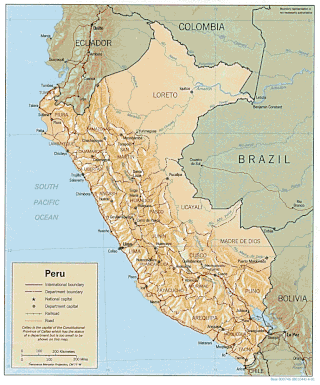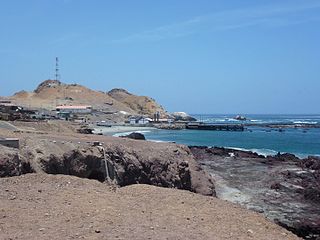Related Research Articles

Peru is a country on the central western coast of South America facing the Pacific Ocean. It lies wholly in the Southern Hemisphere, its northernmost extreme reaching to 1.8 minutes of latitude or about 3.3 kilometres (2.1 mi) south of the equator. Peru shares land borders with Ecuador, Colombia, Brazil, Bolivia, and Chile, with its longest land border shared with Brazil.

Buñol is a town and municipality in the province of Valencia, Spain. The municipality has an area of some 112 km², and is situated approximately 38 km west of the provincial and autonomous community capital city, Valencia. It lies along the Buñol River and is surrounded by the mountain ranges La Sierra de Las Cabrillas, la Sierra de Dos Aguas and la Sierra de Malacara y Martés.

The carob is a flowering evergreen tree or shrub in the Caesalpinioideae sub-family of the legume family, Fabaceae. It is widely cultivated for its edible fruit pods, and as an ornamental tree in gardens and landscapes. The carob tree is native to the Mediterranean region and the Middle East. Portugal is the largest producer of carob, followed by Italy and Morocco.

Lambayeque is a department and region in northwestern Peru known for its rich Moche and Chimú historical past. The region's name originates from the ancient pre-Inca civilization of the Lambayeque. It is the second-smallest department in Peru after Tumbes, but it is also its most densely populated department and its eighth most populous department.

Piura is a coastal department and region in northwestern Peru. The region's capital is Piura and its largest port cities, Paita and Talara, are also among the most important in Peru. The area is known for its tropical and dry beaches. It is the most populous department in Peru, its twelfth smallest department, and its fourth-most densely populated department, after Tumbes, La Libertad, and Lambayeque.
Locust tree can mean:

Prosopis alba is a South American tree species that grows in central Argentina, the Gran Chaco ecoregion, and part of the Argentine Mesopotamia, as well as Bolivia, Paraguay, and Peru. It is known as algarrobo blanco in Spanish. Spanish settlers gave it that name because of its similarity to the European carob tree. Other common names come from Guaraní, including ibopé and igopé.

Prosopis nigra is a South American leguminous tree species that inhabits the Gran Chaco ecoregion, in Argentina and Paraguay. It is known as algarrobo negro in Spanish, which means "black carob tree". It is also variously called algarrobo dulce, algarrobo morado and algarrobo amarillo.

Tondero is a dance and guitar rhythm from Peru that developed in the country's northern coastal region (Piura–Lambayeque).

The Morropón Province is one of eight provinces of the Piura Region in Peru. The province was created in 1936. Its administrative center is in the town of Chulucanas.

The Chala or "Coast" is one of the eight natural regions in Peru. It is formed by all the western lands that arise from sea level up to the height of 500 meters. The coastal desert of Peru is largely devoid of vegetation but a unique fog and mist-fed ecosystem called Lomas is scattered among hills near the Pacific coast as elevations up to 1,000 metres (3,300 ft).

Prosopis pallida is a species of mesquite tree. It has the common names kiawe, huarango and American carob, as well as "bayahonda", "algarrobo pálido", and "algarrobo blanco". It is a thorny legume, native to Colombia, Ecuador and Peru, particularly drier areas near the coast. While threatened in its native habitat, it is considered an invasive species in many other places.

Tara spinosa, commonly known as tara (Quechua), also known as Peruvian carob or spiny holdback, is a small leguminous tree or thorny shrub native to Peru. T. spinosa is cultivated as a source of tannins based on a galloylated quinic acid structure. This chemical structure has been confirmed also by LC–MS. It is also grown as an ornamental plant because of its large colorful flowers and pods.

Schinus molle is an evergreen tree that grows to 15 meters. It is native to an area from the Peruvian Andes to southern Brazil. The bright pink fruits of Schinus molle are often sold as "pink peppercorns" although S. molle is unrelated to black pepper. The word molle in Schinus molle comes from mulli, the Quechua word for the tree. The tree is host to the pepper-tree moth, Bombycomorpha bifascia.
L'Alqueria de la Comtessa is a municipality in the comarca of Safor in the Valencian Community, Spain. Traditionally based on agriculture, the cultivated area occupies most of the communal lands. In the dry part, there are olive trees and carob trees. In the irrigated part, which occupies a more important place, the cultivation of oranges is dominant.

Locust bean gum is a galactomannan vegetable gum extracted from the seeds of the carob tree and used as a thickening agent in food technology.
Algarrobilla, small carob in Spanish, also written algarovilla, may refer to :

Pacasmayo is a city in Northern Peru, in the Pacasmayo province, La Libertad Region. It is located 108 km north of Trujillo city.

Lake Conache is located in the village of Conache, in Laredo District, near Trujillo in the Peruvian region La Libertad.
References
- ↑ Rodriguez. Tercer Encuentro de la Agroindustria: Rural Tarapoto Marzo De 1997 (in Spanish). IICA Biblioteca Venezuela. ISBN 978-9972-47-018-9.